#META EVERYWHERE
Explore tagged Tumblr posts
Note
AAAAH so I’ve been inactive/lurking for years but I need to come out from the shadows for a second to THANK YOU SO MUCH FOR YOUR OFMD METAS. Especially your takes on Stede in 6/7!! I know a lot of people have said it, (bc it’s true and right) but you describe and explain things SO WELL IT BREAKES MY HEART. AGH. THANK YOU. I feel like this last episode especially was just the culmination of Stede putting all his core insecurities into a pressure cooker and leaving them there while he focuses on everything else. We all love to point out that this man just does NOT talk about any of his core issues while they are VERY MUCH still issuing! He still believes everything bad that has happened is all his fault!! He’s still thinking about that blood spattered little boy at his core!! (side note: a famous, deadly pirate getting killed via Stede throwing a violin at his head was NUTS. that concept is NUTS. I love this show.) Honestly I think at this point it’s just finally Stede’s turn to have a breakdown, and that’s where at least some of his behavior at the end of ep 7 is coming from. Most of our major characters this season have had one where they break hard, find support, and come out on the other side of it at least a little better. He has NOT. He hasn’t had a Stede centered heart to heart with anyone yet!! He’s grown so much in so many other ways, but like you’ve said!!! He just will not OPEN UPP. Because it’s scary!! What if you finally say the thing you know is fundamentally wrong with you, and the people you love finally see you for what you are?? Why would you do that when you can just try to fix it by shoving it down and making yourself into something else instead? And then what do you do when that all goes to hell anyways?? You act a fool and get your ass beat by a pirate queen is what 😭😭. It feels like we’ve all been side eying Stede not talking about his issues and the show just went, “Yep! For sure! Now look at what it’s done for him.” That compared to everyone else working through things and starting to move on?? Owie. Absolutely delicious- but also I think I’m different now. Like, as a person. And I trust this show to work it out!! I think Stede will get there eventually!! But like. Fuckin OWIE.
(This is an absolute WALL of text good god. Thank you again for sharing your thoughts and being yourself <33 I’m going to cry into the floor and try to function like a normal person)
...
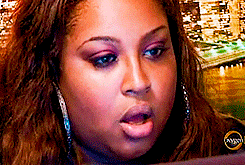
Well goodness, do I feel honored to be graced by your presence and YOUR lovely thoughts too! Because your so-called "wall of text" is SO beautiful and so thoughtful and so very ACCURATE AS WELL. AND IT SUBSEQUENTLY PUNCHED ME IN THE KIDNEY </3 SJDKLS.
Because Lord, you're right, how do we expect this man to function when he hasn't had his bathtub moment yet? And to think--he ALMOST could have. Ed was opening the door and giving him a place to talk and share vulnerabilities. Ed came in and started talking about his DAD, which as we know is a MAJOR piece of vulnerability for him. He really came in and set the stage for them to go in that direction...
Onllllyyy for adrenaline and desperation and perhaps a bit of fear to still prevail.
Like, it kills me. HE kills me. People give him the opportunity. People try and extend an olive branch. And yet still, he hides behind numerous walls. He helps other people before he helps himself. His bathtub was used for the benefit of others in episode 6 as opposed to his own. And I think that's a perfect representation of his character as a whole, really.
And man I knew, I KNEWWWW he was going to have so much to work on when the season opened up with that dream sequence. I think that dream sequence spoke on SO MUCH of what's going on in his head. It really cracked his psyche right on open. The beard, the ruthlessness, the deeper voice, the posturing, the way he doesn't "gain access" to Ed until after he's made a kill...
It was all just SCREAMING self-image issues and toxic masculinity issues and trauma to me. Not to mention how DRAMATIC of a contrast it was to Ed's. Ed loves his darling, sweet, fantastic goldfish for who he is. And it kills me that Stede can't see that yet.
But yes, I do believe we'll get there. I believe that's WHY all of this is being shown/set up. The show is very clearly telling us that Ed and Stede have issues to work through, and that their relationship is going to take mutual effort to become mature and grounded.
...But man, is the climb up to that A BIG OWCHIE INDEED LMAO.
#Answered#oh-dear-gracious#Stede Bonnet#OFMD#OFMD Season 2#OFMD S2 Spoilers#Gentlebeard#Blackbonnet#just going to throw this into my-#Revenge Rambles#tag because META LOL#META EVERYWHERE#I also think I'm particularly passionate and also DEFENSIVE of him because this is striking personal chords l m a o#Like I've experienced similar instances of having to force myself to do things uncharacteristic of me simply to try and win respect/approva#And have ALSO prioritized others' wellbeing over my own#NOT TO GET TOO DEEP ON MAIN HERE HSDKLS BUT LIKE#STEDE JUST.......#STEDE JUST RESONATES WITH ME IN QUITE A FEW WAYS#SO#YOU KNOW HSKDJLSHDLKS#but again thank you so much for coming over and talking because YES#IT'S ALL JUST SO?????????#LIKE IT HURTS#A LOT LMAO#BUT MAN#DOES IT GET OUR TRAINS OF THOUGHT GOING HUH#CHOO CHOO
17 notes
·
View notes
Text
I’m actually really sad I have to communicate this, but yall should REALLY consume fandom media created by actual, human people, not AI.
#I don’t have a PROBLEM with c.ai girlies — shit - I use the app sometimes when I’m bored#but for the love of god fandom was created for people BY people#specifically this is about writing. ‘wah I wanna fuck my favorite character but the big bad filter on c ai won’t let me’#YOU HAVE WRITERS!! LITERALLY!! EVERYWHERE!!! THAT POST BEAUTIFUL SMUT PIECES!!!!!#text#text post#fandom#fandom meta#ai#anti ai#writing#writers on tumblr#artists on tumblr
461 notes
·
View notes
Text
Female Guidance in Aventurine's Life
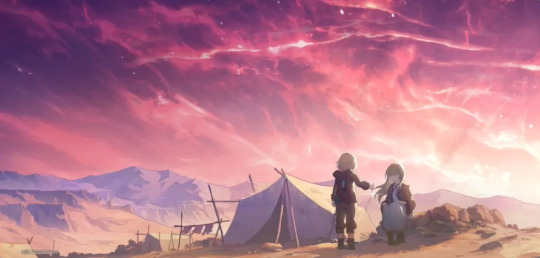
One thing I haven't seen discussed in much depth yet, but which I think is especially interesting, is the consistency of female guidance in Aventurine's life: Every single person who we have seen on screen offering Aventurine assistance or making a positive difference in his life is female (with one exception, yes, I'll get there).
Under the read more cause it's longggg:
Before even diving into his family, let's just get the obvious out of the way: Aventurine is, at least supposedly, blessed by a goddess. The very origin of his good fortune--be it actual blessing or curse--comes from the literal "mother goddess" who watches over him. This is one of the only instances in Star Rail where a god character is specifically given a gender, and Gaiathra is not ever ambiguous. She is the classic female fertility goddess with all the trappings of other famous triple goddess figures of the real world. Aventurine's personal belief in the goddess may be shaky, but he nevertheless continues to treasure his people's faith. Thus, at the core, we can say Aventurine is a character who is guarded by the most quintessential mother figure possible.
Now, with the most obvious out of the way:
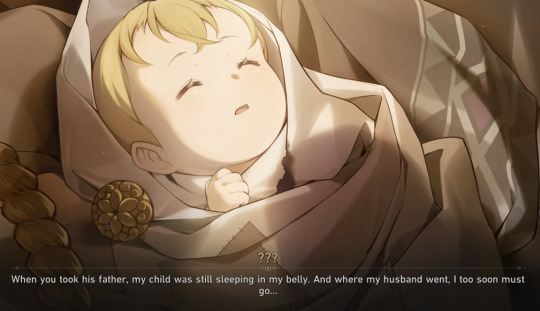
We know that Aventurine's father died before Aventurine was even born, and therefore he would not have any memories of his father, leaving him to be raised by his mother and sister.
Both women clearly made an enormous and lasting impression on Aventurine; they haunt every single one of his memories of Sigonia and are the key elements of the family Aventurine longs to return to. While he flirts with the concept of death as a way to see his family members again, it was also his mother and sister who instilled in him any sense of self-worth and meaning to his existence, the only things keeping him from giving up on living. His mother believed him to be blessed; his sister insisted to his face that not even the only remaining remnant of their mother had any value in comparison to his life.
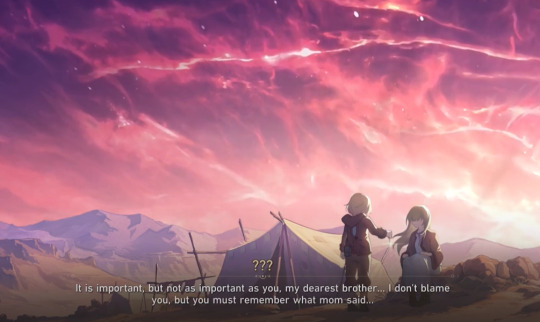
It is for his sister that Aventurine first begins expressing a self-sacrificial nature, and from his sister that this self-sacrifice is reinforced when she uses herself as a shield to help him escape massacre at the hands of the Katicans.
It is also from his sister that Aventurine learns many of the deeply meaningful actions he holds onto to the present day, despite having been so far removed from his own culture.
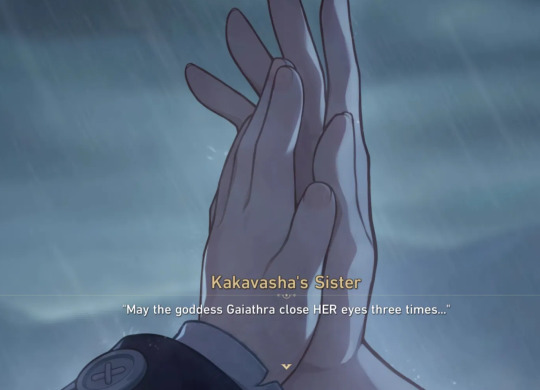
Conversely, every one of Aventurine's early negative experiences on screen appear to have been driven (at least primarily) by men.
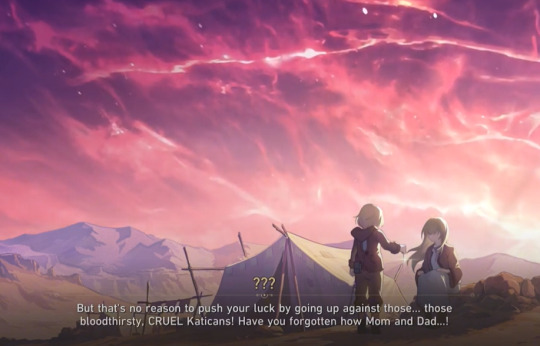
Although the Katican tribe of course would have both men and women, the tribal societies on Sigonia appear to be on the fairly traditional side, with Aventurine's mother staying at the camp with her child while his father was the one to go out and hunt for offerings for Gaiathra. This is also supported by Aventurine asking Jade to take him to her "chief" later on. Therefore, it is likely (although of course not guaranteed) that a majority of the Katicans' army was male, and that Aventurine's early experiences with outsiders consisted almost entirely of indiscriminate pillaging and massacre at the hands of what the Avgin viewed as savage, invading warriors. In separate instances, Aventurine was traumatized by these warrior figures three times--first with the loss of his father, then his mother, and then finally his sister.

And even their hope, supposed to come in the form of the "men in black" from the IPC, completely abandoned them, leaving Aventurine once again betrayed by masculine figures that were supposed to be there to protect him. Led by Oswaldo Schneider, another cruel male authority figure, the Marketing Department of the IPC permitted the wholesale slaughter of Aventurine's people--something which we know Aventurine is now aware of.
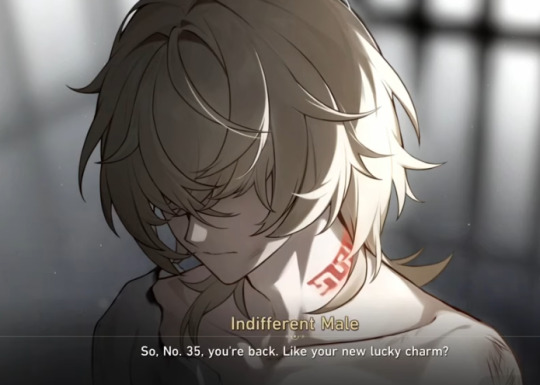
Then, of course, the next piece of Aventurine's backstory we're given is his male slave master. I don't really need to say anything about this, do I? This man violated Aventurine's human dignity and bodily autonomy, and forced Aventurine's hand in a life or death battle for which Aventurine still punishes himself mentally, even years in the future.
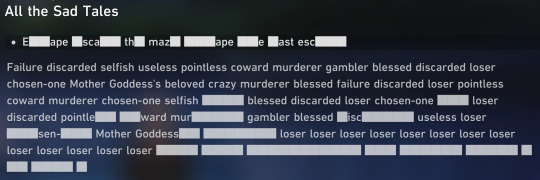
In part to escape the difficulty of his situation and rise to a position where he would have enough resources to--he thought--help his people, Aventurine joins up with the IPC. But when he attempts to make contact with a powerful man in the organization, Diamond, he is instead met by a woman, Jade, who against Aventurine's own expectations determines that she will raise Aventurine up (or use him as a tool, depending on how you currently choose to interpret Jade's motivations), granting him wealth and status beyond his imagination.
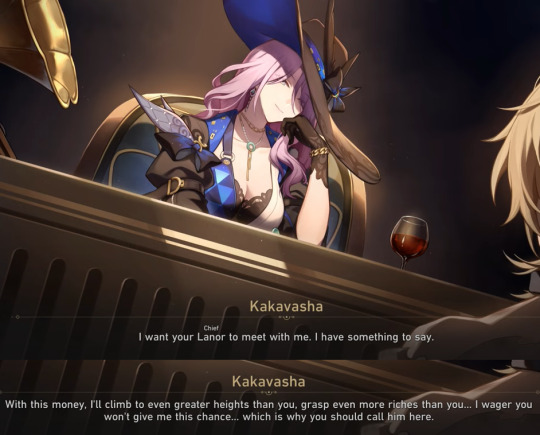
(And this line in particular is interesting, because you can take it one of two ways: 1) Aventurine comes from a patriarchal planet that traditionally put men into positions of power [thereby making his own slavery an emasculating act, aligning him further with disenfranchised women]; thus, he is making the assumption that to get anywhere in this organization, he will need to work with a man; or 2) He actually was counting on Jade taking his bet and helping him right from the beginning, because Aventurine perceives women as inherently more likely to protect and aid him than men would be.)
In the end, Jade does exactly as she claims she will, launching Aventurine into a position of power while also closing golden handcuffs around his wrists. She positions herself not only as his supervisor, but as his advocate and ally. She entrusts him with her Cornerstone, a sign of significant faith in his abilities. She even seems to be keenly aware of his bias towards the mother figure, referring to him as "child" in their conversations.

Whether this is genuine or a manipulation tactic can certainly be debated (and I'm not inclined to think at this point that Jade is a genuinely good role model or selflessly supportive person in Aventurine's life), but whatever the case, women are the only people Aventurine even remotely considers to be "in his corner."
We see this even earlier, in Aventurine's call to Topaz. Like with the example of his mother and sister, Aventurine trusts in Topaz's ability implicitly, and considers her above anyone else when it comes to completing the mission in Penacony.

Although of course we don't know if Aventurine has any other friends or allies among the Strategic Investment Department, it seems very likely that Topaz, yet another woman, is the one he is closest with. At the very least, she is the only IPC character (so far) that Aventurine has a complimentary voice line for, one that shows his respect for her talent:

Over and over again, the story aligns Aventurine with female figures in positions of authority, and demonstrates that he is comfortable (although maybe not too comfortable, in the case of Jade) with relying on them and trusting their judgment, just as he did with his mother and sister.
And this pretty much goes off the charts in Penacony, where Aventurine has more involvement with the female cast than virtually any other non-female character (even the Trailblazer!). We set the pattern off right away, with Aventurine immediately being placed into a negotiation situation with Himeko, respecting her role as the Express's leader and working to get himself aligned with the Express by acquiescing to her request for support.
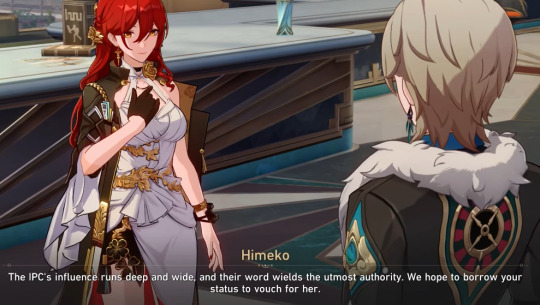
Then there's the fact that Aventurine is the one who finds Robin's body, an event which, although he didn't let it show too much, was almost certainly traumatic for him, given the violent death of his own sister.
Next, twice in Penacony's story, we see Aventurine seek out Sparkle for information. He may not personally like her and her comments may be both racist and dehumanizing, but Aventurine does rely on her--being the only character explicitly seeking her aid, which no one else in Penacony seems to want.
In 2.0...

And in 2.1.
Now, say it with me, guys: Aventurine built an entire portion of his grand plan around the idea that if he looked pathetic enough, a female character would absolutely come and help him. And sure enough, the women come through for him, always! Sparkle gives him the exact last clue he needs to confirm his belief that he could use "Death" to reach the true Penacony, sealing the deal for the rest of his plan.
His plan which also hinged significantly on Black Swan's involvement too, another woman that he views as, if not trustworthy, then at least intelligent and hyper-competent.
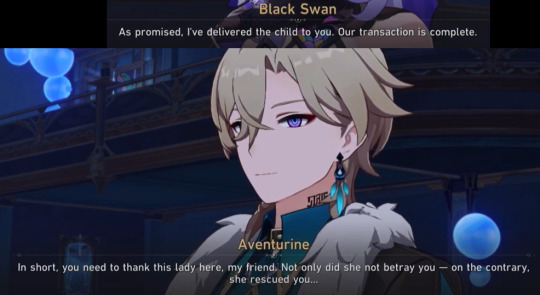
Contrast all this, of course, with the treatment Aventurine receives at the hands of Sunday, the lone opposing male character he faces in Penacony.
Sparkle implies that Sunday would humiliate Aventurine in an unmistakably sexual and degrading way, and Sunday himself professes this same desire to see Aventurine humiliated.
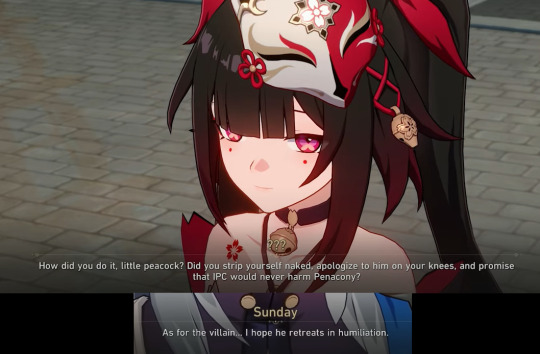
Then we're "treated" to the moment in which Sunday uses the Harmony's (or perhaps actually the Order's?) power against Aventurine, in a scene which is supposed to reflect an interrogation but is also, very clearly, another nonconsensual violation of Aventurine's bodily autonomy and dignity by a man. While ostensibly seeking confirmation of the Cornerstone ruse, Sunday instead subjects Aventurine to unnecessary questions about his past on Sigonia, which recall and force Aventurine to re-endure memories of his trauma.
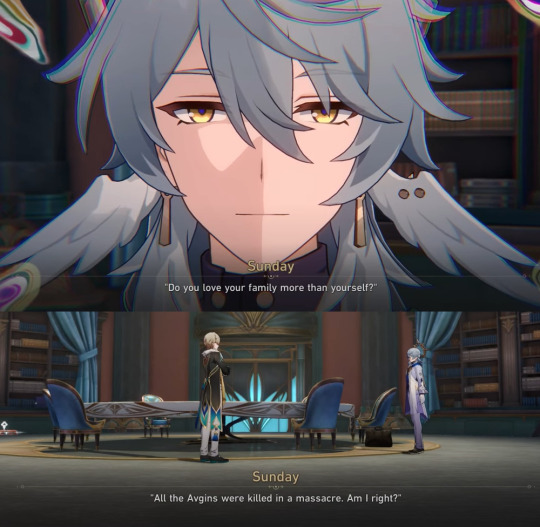
Even if this is what Aventurine prepared himself for and planned to have happen, the pain he experiences is very real, and he suffers both the physical and emotional consequences of Sunday's assault all the way up to his "Death" and possibly even beyond.
(Also, Sunday fans please don't get too up in arms with me for this; I also like Sunday! It's okay for characters to be morally grey!)
I think there's one other interesting example I would bring up here too, and that's Aventurine's conscious decision to weaponize his own masculinity against the Trailblazer. Through the 2.0 and 2.1 Trailblaze missions, Aventurine deliberately acts in an off-putting manner to the Astral Express crew, particularly the Trailblazer, in order to build up to the 2.1 climax where the Trailblazer is supposed to view him as an unrepentant villain and attack him without hesitation.
In order to achieve this uncomfortable, villainous effect, what does Aventurine do? Exactly what other men have done to him.
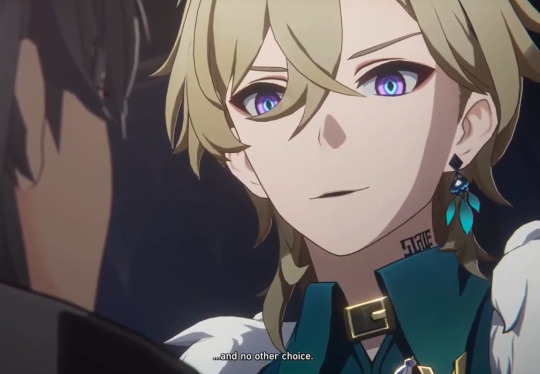
This is especially apparent if you're playing Stelle because of the ingrained societal taboo of a man entering a woman's personal space without consent, but even as Caelus, it is very clear that Aventurine is leveraging behaviors typically used to show dominance: In a complete 180 to all Aventurine's other body language in the game (normally quite withdrawn, frequently in defensive postures with his arms crossed or hand behind his back, almost always standing several feet away from other people), Aventurine violates the Trailblazer's personal bubble, looming over them (Caelus was sitting in this cutscene, lol), forcing eye contact, and commanding the space while informing them that they will have no choice.
For someone who was hunted, enslaved, had his movements restricted with chains, and due to his own slight stature has very likely been towered over by others who were intentionally asserting their power over him all his life, it is clear that Aventurine associates dominant, typically more masculine-coded physically-imposing behaviors with discomfort and even villainy.
Any girl who has ever had a man loom over her like this will realize very quickly: Aventurine wanted to make himself scary so he made himself act more like a bad man.
(Yes of course I know "not all men." I'm not saying every man behaves in this domineering way or that women cannot be domineering too, obviously, just that Aventurine had a very specific image in mind when constructing a "villainous persona," and the physically controlling tactics most typically used by aggressive men toward women was his immediate go-to.)
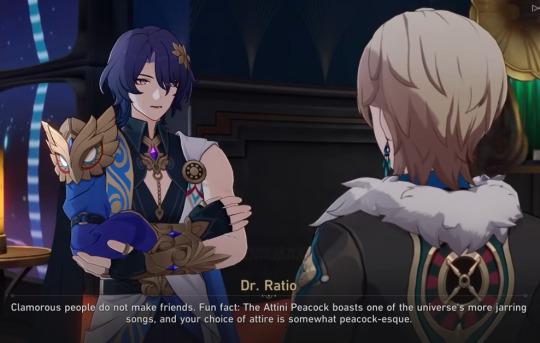
But where does that leave Dr. Ratio, the one male character actually on Aventurine's side?
Frankly, I don't want to derail my post about how intensely Hoyo chose to hammer on the message of "Women will protect you" in Aventurine's story with a discussion about a mlm ship, but the take-away here is going to lead in that direction anyway--so yes, Dr. Ratio is the exception.
What is interesting is that he does not come across as an exception at first, and in fact initially appears as another male character being rude and dismissive to Aventurine. Like, there are still people out there calling Ratio an unrepentant racist for this one.

Of course, it's later clarified that this is an act--likely even these insults were scripted specifically to give Sunday's spying ears the "insight" he needed to exploit Aventurine during the interrogation.
But even though it is an act, Aventurine still has noticeable trouble putting his faith in Ratio. He does genuinely doubt him a few times, despite knowing that they are working together to fool the Family.
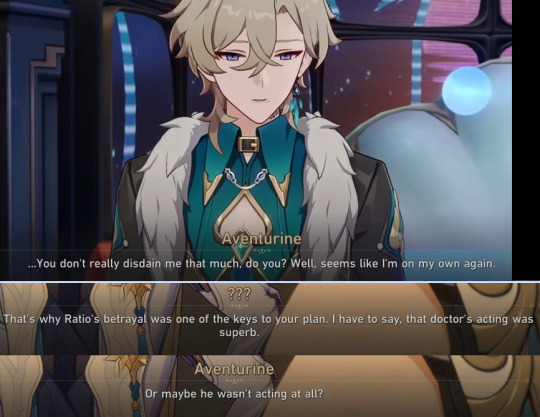
Even his voice line about Ratio confirms that he doesn't think Ratio particularly cares for him; rather, he thinks Ratio simply tolerates him because he's slightly less unintelligent than those around them.
Ultimately, the entire act with Ratio ends up being a mirror of the real scenarios Aventurine has been experiencing with men his whole life (at least as far as we are shown his life). Men abandon him to fend for himself (unwillingly, like his father, or willingly, like Diamond leaving Aventurine to deal with Penacony alone on the inside). Ratio keeps leaving Aventurine completely alone. Men attempt to humiliate him and violate his boundaries (like Sunday and his slave master). Ratio insults Aventurine's appearance and intelligence repeatedly. Men betray him (like Oswaldo Schneider and his men leaving the Avgin to die). Ratio "betrays" him.
I'm not saying when Aventurine devised the plan for their act, he consciously drew up a list of all the ways men had hurt him in the past and had Ratio re-enact them one by one, but like... that's what happened, whether or not Aventurine intended it.
And okay, the shrinking scene in Dewlight Pavilion was just for fun and probably only slightly fetishy, the devs promise; yes, it was supposed to be a joke! ...But it's also not a mistake that this is yet another instance of a male character in a glaringly metaphorical position of power over Aventurine. Aventurine's tiny in this scene! He's completely vulnerable! He's in a dangerous position and the male character could very much hurt him in this moment.

But Ratio doesn't. (In fact, his line here is supposed to be sarcastic, very ha ha--but also, what is Ratio really saying? "I won't do anything to you without your express consent." What a good guy.)
Virtually everything negative that we see in 2.1 is Ratio doing these things as an act at Aventurine's own request. He doesn't actually disdain Aventurine; his own voiceline about Aventurine reinforces that he sees Aventurine as talented and intelligent.
Whatever you think he was apologizing for in their early scene, he's the only person we're ever shown in-game apologizing to Aventurine at all.
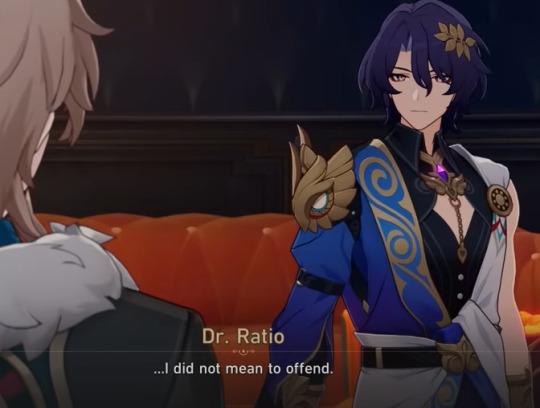
He worked hard to "betray" Aventurine but only as he was instructed to do, and immediately checks in on Aventurine's well-being afterward, even urging him to give up the plan if it becomes too much to handle.
And then, of course, there's the note: "Do stay alive. I wish you the best of luck."
After this point, it cannot be denied that Ratio is unequivocally on Aventurine's side, wants to help him, and is not doing so out of any sense of self-gain but largely because he is a good person who simply cares about Aventurine's fate. By the end of 2.1, it can no longer be doubted that Ratio is the exception to the "gender rule" of Aventurine's life, which--the story shows us again and again--was that guidance, protection, and care for Aventurine come from women, while men repeatedly represent dismissal, betrayal, or pain.
Ratio is, at least as far as Aventurine's story shows us, the proof that men can be good, that things are not as black and white in Aventurine's life as they might appear, and that--if you do choose to ship him with or see Aventurine as attracted to men--his attraction could be validated (and potentially reciprocated) by a male figure who would not bring additional harm to Aventurine's life. Aventurine makes the final decision to live after seeing Ratio's note--the exception to the rule ultimately proves to be the last piece needed to keep him alive.
But I promised I wasn't going to derail my own post about w o m e n, so let me get to the final point, and the one I really wanted to talk about: Although Ratio gets virtually all the credit for "saving" Aventurine in the fandom, Aventurine was actually saved by, you guessed it, another woman.
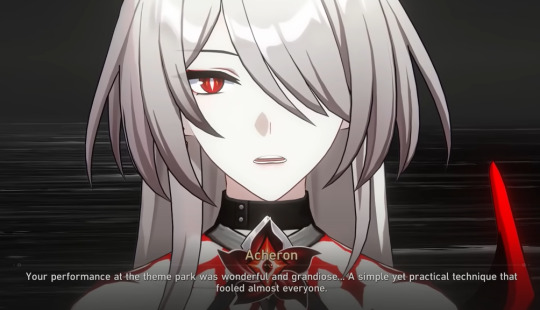
Not going to lie, the reason I started this post was specifically because I wanted to talk about how Acheron and Aventurine's dynamic was completely unexpected but actually fits flawlessly with the theme of feminine guidance in Aventurine's story.
Despite the fact that Aventurine made Acheron's life much harder and actively used her as a chip in his grand gamble, she doesn't blame or chastise him for those actions. Although she expresses some incredulity that Aventurine is actually that lucky, she then turns around and congratulations him for his ingenuity, immediately supporting him despite the fact that they don't even truly know each other.
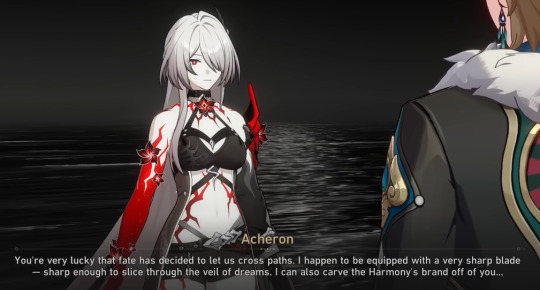
Then it gets even more interesting. Acheron, who frequently hits her companions with deep and sometimes very emotionally fraught questions, asks Aventurine: "Have you never wavered?"
We as players know for a fact that Aventurine is constantly wavering, constantly doubting himself, his luck, and whether he'll even live--or even wants to live--to see tomorrow. But we also know that Aventurine is not forthcoming about those truths, refusing to express them to anyone, even himself. The only way we hear those dark truths is through his "future" self (who by the way, is once again another male figure cutting Aventurine down--of course it's himself but it's also, from the player's perspective, once again reinforcing the message that he isn't going to find safety or kindness in an adult male presence). Aventurine almost constantly deflects and diverts when his emotions or struggles are brought to the fore (unless he's divulging them for the specific purpose of allowing someone else to weaponize them). "I'm fine," he says, like a lying liar who lies.
But he doesn't lie to Acheron.

He chooses to be completely candid with her, to lance open the deepest wound of his life--that he can win and win and win and still have lost everything. The glitz and the glamour has all been stripped away here, at the end of everything, and Aventurine finally feels safe enough to admit that he fears he has absolutely nothing in his life worth living for.
And then, we get this direct parallel: Aventurine looks to Acheron, the woman now before him, for guidance, for explanation, exactly as he looked to his sister in the past.
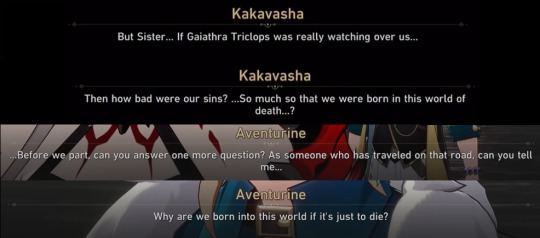
He needs help, he needs answers, and he is continually seeking that help from the female figures in his life, whose support and kindness echo the lost care of his mother and sister.

"Go where you should be," Acheron tells Aventurine, guiding him across the river of death just as his sister insisted that he flee through the rain toward life.
Look guys, Acheron's even the one who reminds Aventurine to look at Ratio's note in the first place because apparently being an emanator of Nihility gives you x-ray vision, but my girl just gets no credit at all for being Aventurine's real savior, come on now!! Yes, Ratio's note was the final reminder Aventurine needed that someone would be waiting for him on the other side, but Aventurine would never have even gotten to the point of being willing to read that note if Acheron hadn't stepped in and provided him an answer to his question.

She feeds him back his own answer: "Why does life slumber? To rehearse the death for which we are not currently prepared." It is Acheron who reminds Aventurine that giving into the Nihility is pointless, and that rather than simply embracing a meaningless death, it is up to humanity itself to find and make meaning by living. It's this, not Ratio's note, that Aventurine gives as his reason for choosing to go on when asked by his own younger self. It's Acheron's words that finally give Aventurine an answer--why do we live just to die? Because there are people we can still make proud. Because when we go into death, we should do so with our heads held high, having achieved our own sense of purpose in this life.
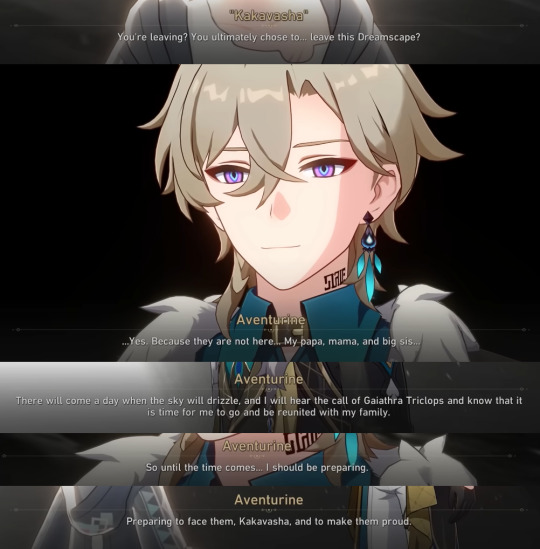
Ratio gave Aventurine a promise: Someone is waiting for you to come back.
But Acheron gave Aventurine a reason: If life is inherently meaningless, doesn't that just mean you are free to give it meaning yourself?
She saved him, as women have been saving him all his life.
Anyway, this has already been horrendously long, but really what I wanted to say is that I think it is absolutely fascinating how consistent Aventurine's writing is when it comes to portraying where his support comes from and who he seeks guidance from. (Psst, just in case you still haven't figured it out, it's women!) In virtually every instance we are shown, we see the message reinforced that women are Aventurine's greatest allies and role models, while male figures are continually positioned to intentionally or unintentionally let him down and cause him distress.
"But women playing the supporting role to a male character is nothing new, Star, why are you so excited by this?"
Because the role women are playing in Aventurine's life is not the subservient supporter and emotional crutch role that female characters all too often play to male counterparts. None of the women in Penacony or Aventurine's past were there to do the emotional labor for him, to be a trophy or prize, or to cater to his needs. They don't exist solely to help him fulfill his character motivations; they aren't following him around waiting for his next request as their only role in the plot.
Instead, with Aventurine's story, we almost have an inversion of gender roles, where the male character eschews the stereotypical "men are leaders, fighters, and stoic heroes" archetype. Instead, no matter how hard he tries to hide it and keep a stiff upper lip, it is clear from 2.0-2.1's story that Aventurine is a deeply insecure, lonely, and explicitly traumatized survivor of genocide, slavery, and exploitation. Unlike most male characters, who are very rarely portrayed as genuine victims--because come on, shouldn't men be strong enough to fight back? Shouldn't men be able to shrug it off when they are hurt, emotionally or physically? (Of course I'm rolling my eyes here!)--Aventurine is belittled, humiliated, emasculated, and victimized on-screen, roles almost exclusively reserved for women, for whom surviving victimization in fiction is seen as noble.
Meanwhile, the women in Aventurine's life take on the roles traditionally given to male characters. They're both emotionally and physically his protectors. Aventurine's sister gave her life to guard his safety; Acheron ensured he could safely pass beyond the river of Nihility into the Primordial Dreamscape. They give him the tools necessary to succeed where he could not succeed on his own. His plan could never have gotten off the ground without Topaz and Jade entrusting their Cornerstones to him. The knowledge and capabilities of the women around him--not their "feminine charms"--are what allow them to help keep Aventurine on the right path even though he does waver. Even women who disrespect him, like Sparkle, still play a positive role in his life, able to provide him insight gained with their own intellect and talents.
When he has no one to rely on and doesn't know what to do, Aventurine is able to continually turn to the women around him, asking for and receiving not servitude or fawning, but their genuine wisdom and guidance.
tl;dr: If nobody else has him, Aventurine knows this random woman he met two minutes ago on the street will have him, because the women in his life literally never let him down.
(It's just so, so good, and ultimately, it should be very clear why Aventurine's story is as popular with women as it is! A+, Hoyo!)
#honkai star rail#aventurine#acheron#topaz hsr#honkai star rail meta#character analysis#there's a bit of#ratiorine#in here too#but mostly I ramble about WOMEN#thematic parallels#thematic parallels everywhere#it's long#I'm sorry but not really#sometimes you act like a normal fan#other times you're me#and write essays that wouldn't be out of place in gender studies class#also I hit the '30 images per post' limit and had to make do#please ignore the terrible merging I did of the photos#don't perceive my MS Paint job
973 notes
·
View notes
Text
thinking about that post that said the real horror of spn was the ways abuse will resurface and thinking about how season 1 is so explicitly intensely overwhelming about domestic violence and abuse in the home…………….there’s something in the pipes, there’s something in the walls, there’s something in the closet the children see at night. we know, but we can never say it
487 notes
·
View notes
Text


[The Forgotten Land Roleswap: Chapter 2 63-64]
The first panel on page 63 references the delicious Candyland AU by @das-a-kirby-blog🍬
<- Previous
Next ->
#candy. candy. candy. candy.#thank you for letting me borrow your au for a panel das. hehehehe. it really is our heroes' dreams come true#also!! the lore! THE LOOOOOORE!!!!!#-elmo with fire background meme-#so these are my personal head canons for the energy types in the Kirby universe...#I mean look at the irl merch. Four pointed and five pointed stars are everywhere. dreams and light!!#chaos elfilis and void soul are both blobby things#soul is like a fancy five pointed star like we see in Leon's soul#there is a method to my madness!#forgotten land roleswap#king dedede#meta knight#elfilis#bandana waddle dee#kirby#kirby and the forgotten land#kirby series#kirby au#kirby comic#roleswap comic#art
303 notes
·
View notes
Text
these days a lot of romance in books, TV, and film leave me a bit cold, which sucks as a lover of romance. there has to be something ~interesting there for me. I've been watching the day of the jackal and it's pretty entertaining so far. but the one thing I haven't quite been able to wrap my head around is jackal's love for his wife, nuria. the show clearly wants us to believe he truly loves her, even if he can't shed his assassin skin and lies like crazy to her. he spies on her. he dreams about her. he thinks about her constantly. even more so than the baby which I (and the show apparently) regularly forget exists.
the chemistry between eddie redmayne and ursula corbero isn't necessarily the issue even though it is middling. ursula certainly does the best with what she's got, which isn't much. but I always struggle when shows place us in an established marriage or relationship and tells the audience how much the two characters love each other, without really being convincing of why they go to the lengths they do because of this love. the jackal is a sociopath with a hundred different faces (though we spend quite a bit of time with him in his true face). he has no qualms whatsoever about killing innocent people to accomplish his objectives. that's established within 20 minutes of the very first episode. so what does it take for this murderer-for-hire to fall in love? why should we be so convinced of this cold-blooded killer's love for his wife? what is it about her that made him fall in love? and vice versa? the show doesn't even try to make us second guess this love. on some level, I'd be obsessed with a suave killer brought to his knees by a woman to the point where he starts a family with her. the deception, the two separate lives, the cat and mouse of it all. but everything about them is spectacularly bland.
throughout the series nuria is constantly questioning who she fell in love with. but who did she fall in love with? in episode 7 we get flashbacks of their first meeting, at a restaurant where jackal is a regular and where nuria works as a waitress. she's hot and vivacious and effortlessly charming. he's a mysterious loner who seems sweet. jackal takes a shine to her and later asks her on a date, to which she immediately says yes. and that's it. that's pretty much all of the flavorless context we have for their relationship. we're simply supposed to believe they fell in love with each other. she doesn't even make him work for the date. there's no push and pull there. she's not even a calculating golddigger or anything, just completely guileless. our favorite sociopath fell in love because she's just that charming? our charming waitress falls for this boring and rich-looking foreigner and that's it? and then we're told that she's completely trusting of him up until the ~turning point. ok. I don't believe the show is trying to pull wool over our eyes. they very much want us to believe there's love there. but there's just nothing convincing me of why these two characters love each other. this failmarriage is of no interest to me.
otoh, the connection jackal has with zina is compelling and sexy. this mysterious corporate shark archetype of a woman who dared to meet an assassin in person. who went to bat for this assassin even when her bosses were not convinced he was the man for their goals. who broke into this assassin's temporary lodgings and withstood his menacing energy. who wasn't afraid to yell and put pressure on this scary assassin. I'd be more obsessed if the actress was better at acting and there was actual chemistry between her and eddie. alas.
otooh, there is ALSO serious messy romantic potential with bianca. also a sociopathic liar. also a married woman (who we're also supposed to believe loves her husband. lol.) with a child. a woman who will do anything to catch jackal. a woman who has no qualms about using innocent people who get killed in the process (even if she does feel some degree of guilt about it). like the parallels are allll there. but she's black and we all know how that goes. in another series jackal would be intrigued and also as obsessed with this mi6 agent who somehow always finds him. sigh.
#the day of the jackal#day of the jackal#two women who've seen his true face in different ways#I don't expect the finale to surprise me on the romantic front#unless we find out the show and nuria have been duping us all which is doubtful#there's going to be a season 2 so maybeeee there's still hope#lashana lynch is so good too#rolling my eyes at the cop role but her character is simply too delicious of a wreck idk#and sorry to poor sweet ******#that was clearly never going to end well lmao#I want to read more meta about this show but the tag is so dead and everywhere else is so racist el o el the neverending dilemma#the politics in this show crack me tf up#came back to say i just imagined gugu mbatha-raw as zina and omg#she's def too far in her career for such small roles but wow what could have been
81 notes
·
View notes
Text
Atp, I’m just going to have to start believing everything I hear about shondaland, because this just look at this article

In the lead up to Wicked, Jonathan Bailey was nominated for an Emmy, for an explicitly queer show as an openly gay man.
To imply that “no one” seemed to care that he could act, in addition to being just an outright lie, that a simple fact check would prove wrong, is just so vile and nasty.
#bridgerton#fellow travelers#wicked#jonathan bailey#meta#shondaland#downplaying the show that actually treated him like a lead and put him everywhere#on top of how they treat Simone#do you know that the s4 cast list still doesn’t mention her?#yup not even now after her 262828 confirmations#like atp what is this if not targeted disrespect
86 notes
·
View notes
Text


I’ve seen a few posts calling attention to the similarities between Bob and Dallas and I haven’t been able to get it out of my head. Specifically I want to call attention to this:
Only one person ever told them no, but it wasn’t the no they needed.
Everyone their age is afraid to tell them no, they always get what they want. For Bob it’s because he leads, for Dally it’s because he’s a Hood- both of them have a reputation and live up to it. Bob’s parents won’t tell him no because they don’t think they have to any trouble he gets into is anyone’s fault but his (because blaming him would point out their bad parenting) and Dally isn’t around his dad enough or the man doesn’t give enough of a shit. The difference is that Bob wants his parents to parent and feel - Dally doesn’t know if he wants anything anymore.
The only people to ever say no in a way that affected them were Cherry and Johnny. They said it and came out unscathed when anyone else would’ve gotten hurt. Cherry refusing to get in the car and aid in his drunken antics (even if she later caves to social pressure) and Johnny telling Dally to lay off the girls. The difference being Dallas silently stalks off and listens…
These are the “no” they’d listen to but not one they needed. Not the law and attention they both lacked… both of their behaviors and personalities are cry for help that goes ignored by adults and friends alike— who assume it’s just their nature.
It goes to show that sometimes we all have the same types of problems regardless of socioeconomic class, it’s just what they make someone that differs. Bob is praised and held up while Dally is seen as the lowest of the low.
In the end they both died violent and young and desperate. Failed by the same systems and structures.
#things are rough everywhere#parallels#the outsiders#outsiders 1983#outsiders#outsiders novel#outsiders meta#dallas winston#dally the outsiders#bob sheldon#robert sheldon#Bob the outsiders#charecter analysis#comparison#moral#greasers#socs#cherry valance#johnny cade
162 notes
·
View notes
Text
The most "dad-like" thing Shiro ever does is this:


#Takashi Shirogane#Shiro#You're nothingness but shining and everywhere at once.#Lance McClain#Voltron: Legendary Defender#Meta.#VLD Meta.#Shiro is NOT the Paladins' father.#All four of them would tell you as much.#Holding him to the standards of an actual father is utterly asinine.
76 notes
·
View notes
Text
i know that the witch king as we know him probably hadn't been fully conceptualized early on when we had IS1 but i think it would have been hilarious had we found out that Ceobe had also somehow broken into and out of the genesis spire since like, one of the IS collectible is the fucking Witch Kings Horn Itself meaning that ceobe had to have one point seen it and recognized it as super cursed and thus also Taken It
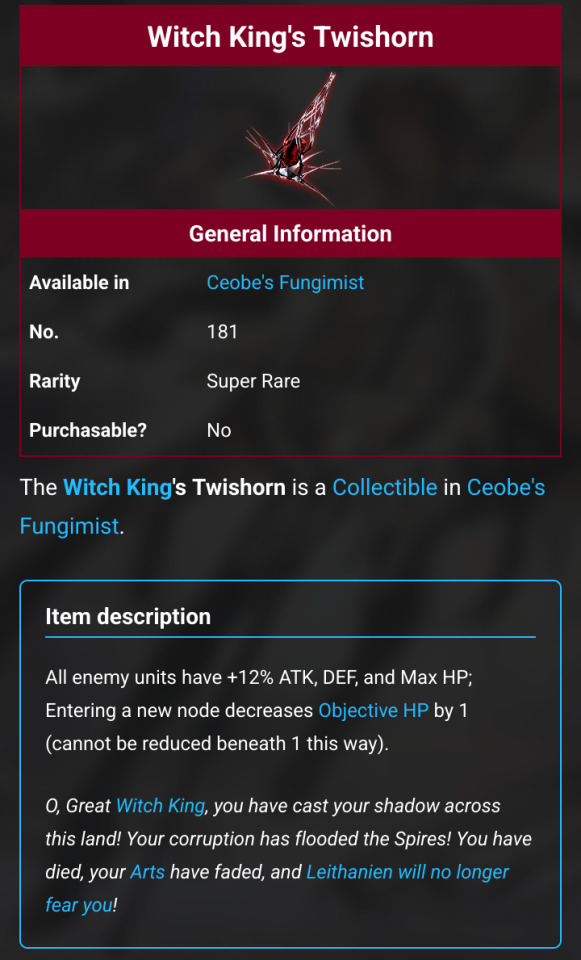
like imagine in the final sections of zwillingsturme when the witch king is talking to fremont and he's like "yes the liches of the sarkaz are some of the only few beings to have reached this place. the ancient feranmut of yan, the ascended consciousness of the ocean, the travelling machines from beyond the fake sky..." and then his face twists. "...that one weird perro that one time who made off with one of my horns"
#-in deep contemplation- he had divined the next century of events... do you think he foresaw the scantily clad perro female food vendors#zerav meme#zerav meta#arknights#ceobe#ceobe everywhere system
175 notes
·
View notes
Text
No rest for the wicked
What often keeps my mind occupied and worried for the last couple of... weeks, or even months, maybe, is what might happen to Stolas's relationship with Octavia in the near future.
We know something bad is brewing. The trailer gave us enough information to freak out but learn nothing from it. I think though that I have found yet another foreshadowing, and I am sad I did. I was not sure if I should post it since predictions and speculations are not quite my style, but fuck it, I’ll roll with it. I want you to suffer with me <3 Besides, after yesterday's @tealvenetianmask's wonderful post about Stella and how society enables her behavior, and my rambly reblog, which delves more into Stolas's relationships with Octavia and how they are affected, I decided I need to let it out of my system.
So, you see... while I believe this screenshot is our last hope for us, the Stolitz nation—that these two dumbasses will have ANOTHER chance to talk properly...

It implies that something arguably worse than their breakup is going to happen. Something on the 'whole palace is in ice and Stolas is in immediate mortal danger' level of 'worse.' Something bad enough to make them forget all the shit they’ve gone through with their disastrous miscommunication and unite to face a common threat.
Andrealphus.
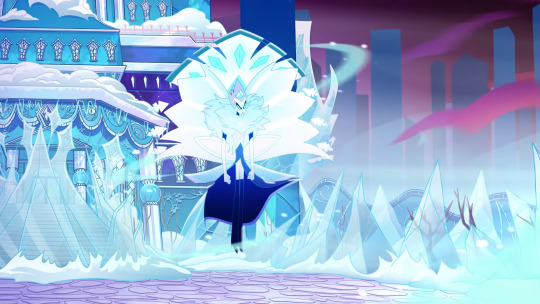
Something that would make Stolas to leave quickly and forcibly. Run for his life. Disappear, sweeping off his trail, without Octavia knowing...
And let her think he ran off with Blitzø.

Are you gonna run off with him and leave me behind? Go away, where I can't find you?
Make her run around the palace looking for him and not being able to find him. Because he isn’t there.

Daddy! Daddy... I had a dream! A really bad dream! I was looking all over the palace, and I couldn't find you anywhere! You weren't there!
And the worst part is that it would make her assume the worst: that he left her behind just for a weird red dickhead.
Why?
Because Stolas's relationship with Blitzø has caused a rift between the prince and his daughter.
Because he, unfortunately, has never told her what kind of mother Stella is, or what she has done to him. She is left to believe everything was okay until that imp came around, seduced her father, ruined her family, and wrecked her home.
Because Stolas grew distant and forgot about the important stellar event he promised to show her. Was he wrong for it? Of course not! Stella made everything to throw him off the rails completely that morning. But Octavia still has the right to be upset.
Not to mention that she’s nowhere to be found since that night in Los Angeles… Why isn’t she around? Is she resentful toward him? Is she being kept from him? Or is he keeping her at arm's length because of the assassination attempt and his deteriorating state of mind? What happened?
I can already see how Stella and Andrealphus could use all of it against Stolas, grooming Octavia and simmering her in hatred for him. Bluntly lying about true reasons Stolas fled.
Stolas kept silent about the abuse he survived, hoping to protect Octavia and let her live a perfect childhood. But instead, she won’t have a single soul to support her, since Stolas will be chased off and hated. By her. Surrounded by vultures who now prey on her, who have couped her father and forced him to break the solemn, earnest promise he made to her.

What?... No! No, no, never! I'd never do that. Never...
How fucking tragic is that?
#sorry no happy ending for you today#my bet is we are getting stolitz back together but at the cost of this :(#it's just my educated guess of course#combining all we know so far and Viv's tendencies to stab stab stab and her love for foreshadowing everywhere#but also it's just a prediction so it might be better..... or worse <3#and I am just in a mood for snot and tears#so enjoy <3#helluva boss#helluva boss spoilers#stolas goetia#stolas#octavia#octavia goetia#stella#andrealphus#blitzø#stolitz#stolas x blitz#blitz x stolas#akira's whimpery metas
112 notes
·
View notes
Text
The biggest Easter egg yet
I’ve been meaning to address this for a while now, but @camdenleisurepirates gave me the final push after reading my piece on Gabriel’s cross. Huge thanks for that morsel of motivation, my ADHD brain loves you.
This is going to be yet another long read, although not as extensive as my bookshop statues meta. Still, better get yourself some hot chocolate or another drink of your choice and make sure you’re comfortable!
Now, remember the X-Ray interview with Peter Anderson on Easter Eggs in the opening animation he created for the second season? Forget red herrings, apparently our fandom has a literal red phone box! I’m convinced that this whole scene is a one big — the biggest, actually — Easter Egg, and I’ll explain why step-by-step.
The red phone box Crowley used to warn Aziraphale about the Antichrist and the following Armageddon in S1, the exact one where he left change for an emergency call, seems important enough in terms of the future S3 plot, but there’s so much more going on in this frame. Not only the lift.
The angels
At the very start of this sequence we can see a fragment of an elaborate bridge guarded by cherubs sitting on two columns, maybe globes, leading to a distant structure built over a literal mountain of trash — all elements of the S1 and S2 openings which were consciously picked out by the animators and put together in a very ominous pile.
Ready for some scavenging?
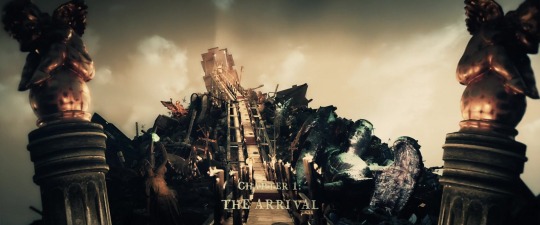

In the Gabriel’s cross meta, I already mentioned the importance of Ponte Sant’Angelo in relation to the ex-Archangel’s statue. Now it’s time to widen our perspective and focus on the full picture — quite literally. Apparently the bridge from the opening sequence has ten statues of angels, exactly as the Italian historical monument.
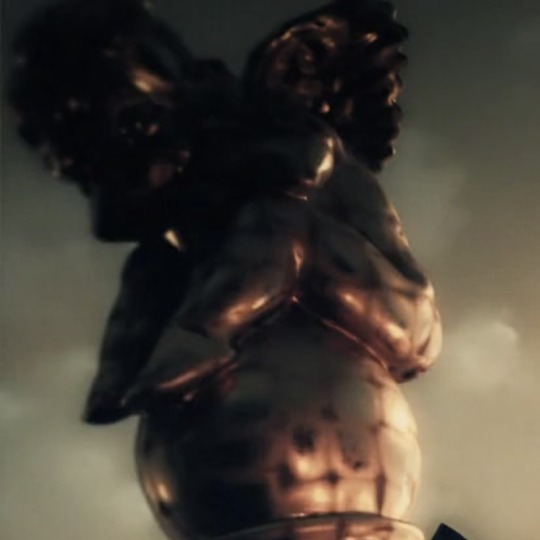
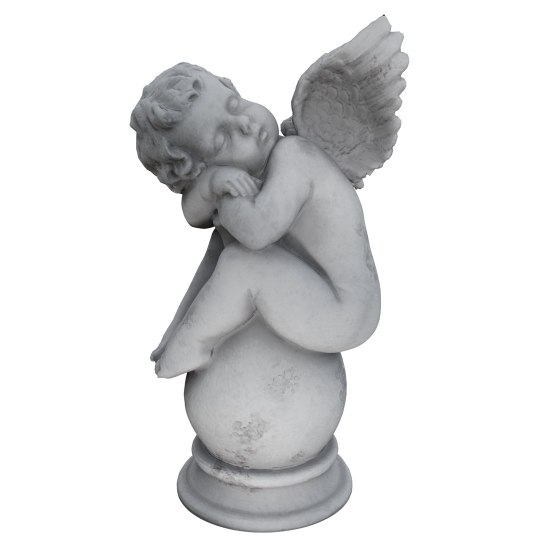
First things first though: the two big cherubs guarding the entry to the bridge might seem familiar to some of you. While they’re obviously not copies of the same statue, a very similar pair of brass cherubs is placed in Aziraphale’s bookshop to symbolize Aziraphale and Crowley. And looking at the screenshot above and the way they sleep or sulk with their backs turned on each other, they are most certainly not talking. The addition of more than one set of eyes is a lovely reference to biblically accurate angel memes though.
If we assume the traditional left-right positioning of the characters, Aziraphale is on the left and Crowley is on the right. Directly behind Aziraphale we can see a ship named “Good Traits”, but in reverse — kinda sorta confirmed by the animator Peter Anderson to be connected to the concept of the seven deadly sins on Twitter. Same that was mentioned recently by Neil in one of his asks.
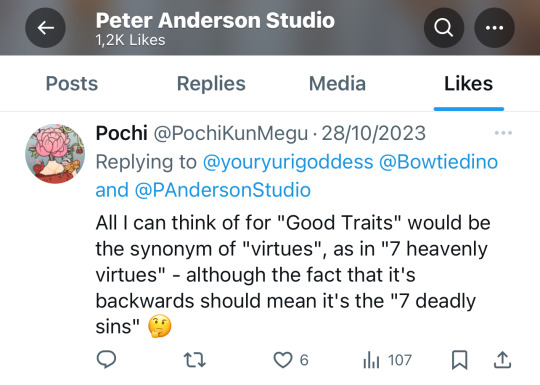
The presence of Gabriel — a renegade Archangel wielding a broken cross — on the right, Crowley’s side, seems to match this theory. It could also support one of the possible interpretations of the very last bookshop shot in the S2 finale.

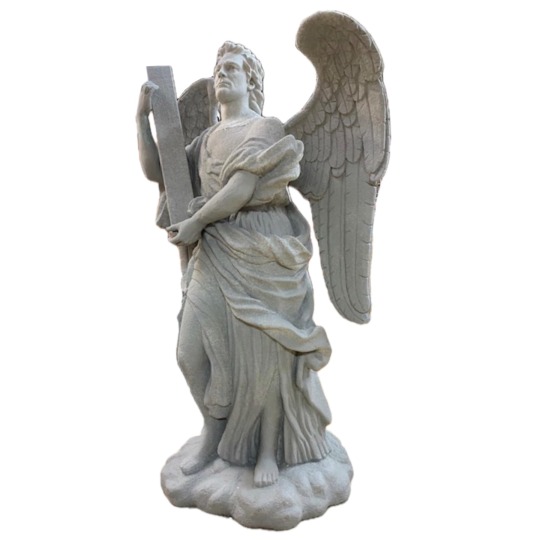
Out of all ten statues, Angel Carrying the Cross by Ercole Ferrata is considered inferior to the others on the bridge in that it appears to be a two-dimensional relief sculpture rather than an unbounded three-dimensional artwork, which seems to match Gabriel’s first impression as a character.
The inscription on the statue reads, “Dominion rests on his shoulders" — that is the weight of the cross that Christ was forced to carry through Jerusalem before being crucified. Even though Gabriel’s burden partially disappeared, the whole bridge and its environment is covered with crosses. It’s clear that we’re looking at a direct parallel of Via Crucis, the Way of Sorrows.
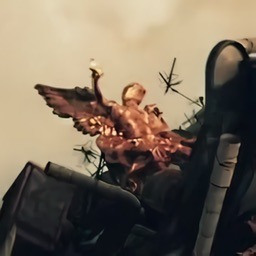
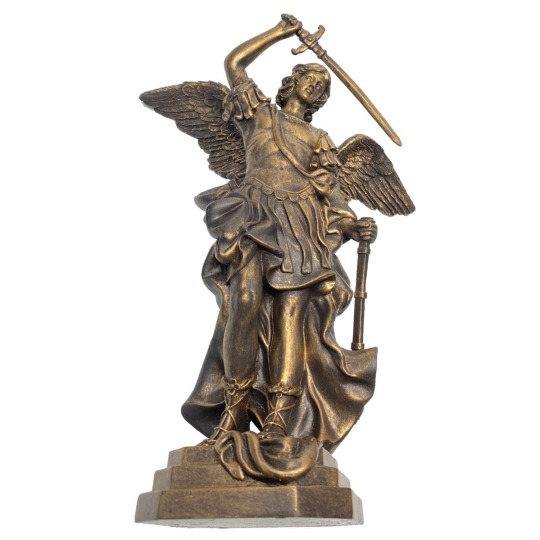
Towering over the Italian bridge, at the very top of Castel Sant’Angelo, is a statue of Archangel Michael, seen as the golden angel on the top left part of the trash pile. Aziraphale’s side, perhaps as his assistant, perhaps a rival? Legends of the Jews mention Michael as the chief of a band of angels who questioned God's decision to create man on Earth. The entire band of angels, except for Michael, was condemned to Fall — which could explain why they have such a good access to the Grapevine That Obviously Doesn’t Exist. And whatever’s going on between Michael and Dagon, perhaps.
In Roman Catholic teachings, Michael has four main roles or offices. Their first role is the leader of the Army of God and the leader of Heaven's forces in the final triumph over the powers of Hell. Viewed as the angelic model for the virtues of the spiritual warrior, their conflict with evil taken as the battle within. The second and third roles of Michael deal with death. Their second role is that of an angel of death, carrying the souls of Christians to Heaven. Michael descends at the hour of death and gives each soul the chance to redeem itself before passing; thus throwing the devil and his minions into consternation. In their third role, Michael weights souls on perfectly balanced scales they are often depicted with as their attribute. In their fourth role, Michael appears as the guardian of the Church. Might be the reason why they’re the closest to the building on top of the mountain.
It looks like Michael lost their sword though, just like Gabriel lost a part of the cross he was supposed to carry. The sword in question was supposed to be used to slay the dragon — Satan, the Adversary — according to John of Patmos and his Book of Revelations.
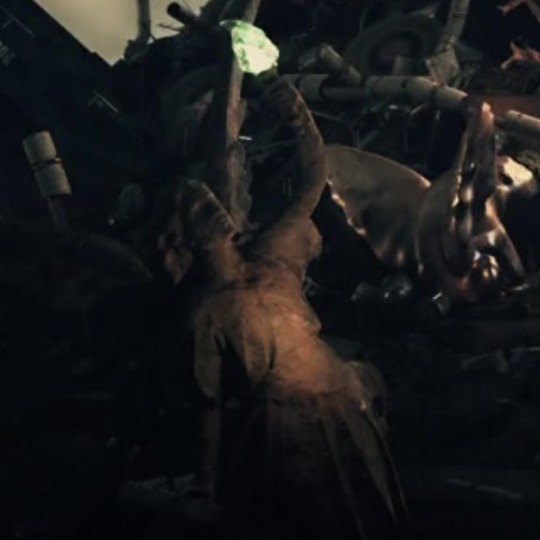
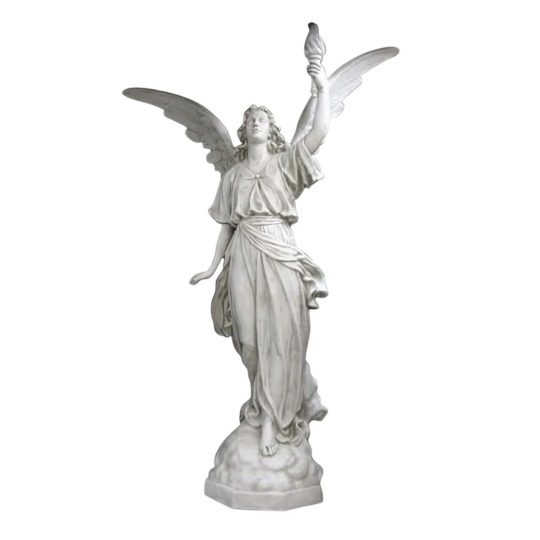
Speak of the devil: interestingly, there are two copies of an anonymous variation of the Angel of Light statue appearing twice on both sides of the bridge. Both the title as well as the statue itself seem like obvious references to one (former) angel literally called the Lightbringer, Lucifer. Perhaps one of them is representing his son, the Antichrist, instead, with the both of them helping out the Ineffables on two opposing — or perhaps only parallel — sides of the bridge?

The light carried by Lucifer appears to be green, a color used in the series as a visual representation of Hell, but on the intertextual level might also serve as a reference to F. Scott Fitzgerald’s classic novel The Great Gatsby and the green light at the end of the Daisy’s dock symbolizing the undying love, desperation, and longing for an unattainable dream. In the story, the color represents the limitations of power and money. Not surprisingly, the novel appears on Jim’s bookshelf and is part of the Good Omens book club — a list of personal recommendations from Neil Gaiman and Douglas Mackinnon for the fans to catch up on before the next series.
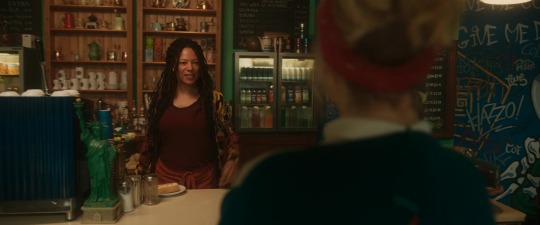
Last but not least, the possible connection to Libertas as the inspiration for the Statue of Liberty, shown multiple times in S2 as a foreshadowing of our character’s trip to America in S3. The related quote of Patrick Henry “Give me liberty or give me death” becomes even more relevant if we consider how the motto of the French Revolution was sometimes written as Liberté, égalité, fraternité ou la mort (“Liberty, equality, fraternity or death”). A lesson surely learnt by a certain angel back in 1793, when he was held prisoner for the last time before being forcefully taken Upstairs in the Final Fifteen.
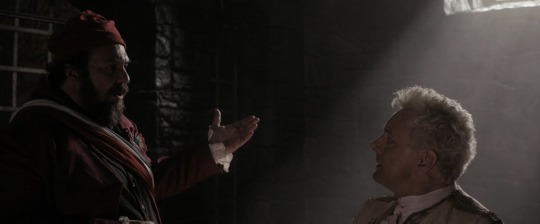
The bridge and the castle
Okay, these are the basic observations. Now a brief historical overview and we will reach the fun bit in a jiffy.
Have you ever wondered about the meaning of this whole complex? It wasn’t always angelic, but named after a Roman noble dynasty. The Aelian bridge was built by the Emperor Hadrian in 134 AD to span River Tiber from the city center to his mausoleum. With time, the remains of more emperors were put to rest in there, until it was plundered and destroyed in a war. Then the remaining structure was transformed into a military fortress and a castle serving as the papal residence in times of war.
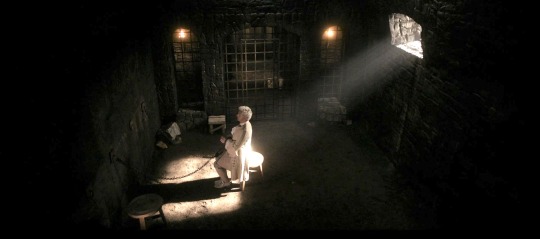
The Papal State also used Sant'Angelo as a prison; the Renaissance philosopher Giordano Bruno was imprisoned there for six years. Executions of the inmates were performed in the small inner courtyard, but they weren’t the only deaths in the area. On the other side of the bridge, in the adjoining Piazza del Ponte, under the watchful eyes of the stone likenesses of two saints, the public executions were held, and the heads of the criminals were brought onto the bridge and exposed to public view there.
As a prison, the former mausoleum is also the setting for the third act of Giacomo Puccini's 1900 opera Tosca. Long story short, the eponymous heroine convinces her lover to feign death so that they can flee together. Unfortunately, they are betrayed and the firing squad shoots at him with real bullets instead of blanks. Tosca believes in the quality of his acting performance rather than the truth, and when the realization hits her, she leaps to her death from the Castel’s ramparts.
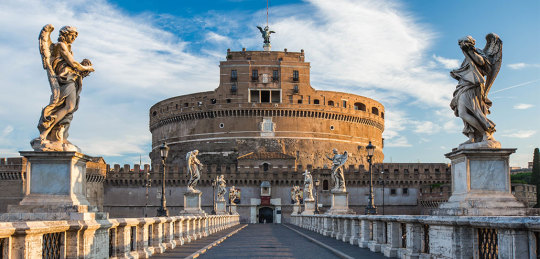
After Nero’s bridge was destroyed, the travelers were forced to cross this bridge as the only direct route to the Vatican and St Peter’s Basilica, earning it the nickname “the bridge of Saint Peter”. That’s why in the 16th century Pope Clement VII erected statues of Saints Peter and Paul at the ends of the bridge, guarding it as they are supposed to protect the entry to Heaven.
In 1688 the bridge was embellished with ten angel statues, five on each side of the bridge, carrying Arma Christi, the Instruments of the Passion. The Good Omens characters represented by those statues in the opening sequence might be other instruments of Christ’s suffering as parts of the system that needs to be overthrown or replaced.
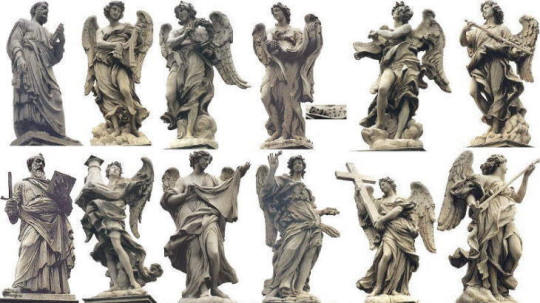
One angel appears particularly important in the context of both the bridge and the Second Coming — Saint Michael the Archangel.
Legend holds that the Archangel Michael appeared atop Hadrian’s mausoleum, sheathing their sword as a sign of the end of the plague of 590, thus lending the castle its present name. A less charitable yet more apt elaboration of the legend, given the militant disposition of this particular Archangel, was heard by the 15th-century traveler who saw an angel statue on the castle roof. He recounts that during a prolonged season of the plague, Pope Gregory I heard that the populace, even Christians, had begun revering a pagan idol at the church of Santa Agata in Suburra. A vision urged the Pope to lead a procession to the church. Upon arriving, the idol miraculously fell apart with a clap of thunder. Returning to St Peter's by the Aelian Bridge, the Pope had another vision of an angel atop the castle, wiping the blood from his sword on his mantle, and then sheathing it. While the Pope interpreted this as a sign that God was appeased, this did not prevent Gregory from destroying more sites of pagan worship in Rome. In honor of the vision and Michael, the bridge was renamed in their name.
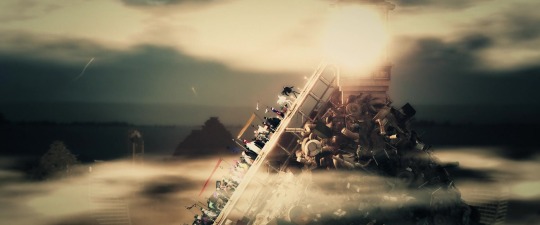
What if the procession from the opening sequence was meant to imitate the procession led by the Pope from the legend? What if Aziraphale, now officially a Supreme Archangel, Commander of the Heavenly Host, is the one actually leading it, with Crowley finally at his side as his partner and second in command, just like it was proposed by him in the Final Fifteen?*
What if by some reason, maybe personal ambition, maybe just a tragic coincidence or situational necessity, there really was an impostor in Heaven, and Metatron — the so called Voice of God who seemingly doesn’t speak up for Herself since Job’s test — has been playing a winged version of the Wizard of Oz all along?
It would make just the perfect sense if not for one tiny detail. The procession we see on the bridge is actually led by Crowley, which doesn’t fit the parallel at all — unless it’s actually a proof of an ongoing body swap, as the mismatched names of the actors could also suggest?
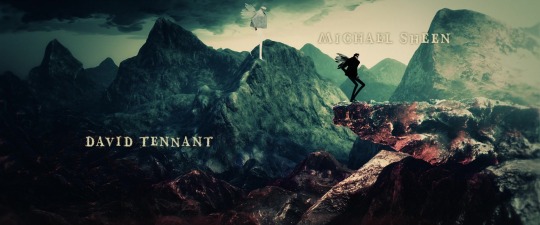
The mountain of trash and the bookshop
The symbolic mountain of trash we can see Aziraphale and Crowley climb is a reference in itself. To an actual mount called Zion, believed to be the place where Yahweh, the God of Israel, dwells (Isaiah 8:18; Psalm 74:2), the place where God is king (Isaiah 24:23) and where God has installed king David on his throne (Psalm 2:6).

In a literal sense, it’s a hill in Jerusalem, although the sources refer to three different locations in different contexts — although for the purpose of this meta the Upper Eastern Hill (Temple Mount) makes the most sense. Its highest part became the site of Solomon's Temple. The same King Solomon the rituals in Freemasonry refer to. Masonic buildings, where lodges and their members meet, are sometimes called "temples" specifically as an allegoric reference to King Solomon's Temple, not actual places of worship. And Aziraphale’s bookshop is built around Solomon’s Magic Circle.
In a metaphysical sense, and especially in the context of the Christian New Testament, it is also believed to be a part of Heaven — the heavenly Jerusalem, God's Holy, eternal city. Christians are said to have “(…) come to Mount Zion and to the city of the living God, the heavenly Jerusalem, to an innumerable company of angels, to the general assembly and church of the firstborn who are registered in heaven” (Hebrews 12:22-23 cf. Revelation 14:1). Just like the procession were following in the opening sequence.
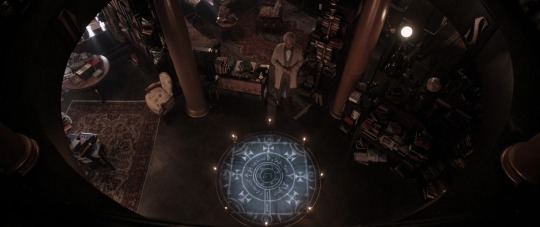
There’s been some speculation whether the lift on top of the mountain could symbolize Aziraphale’s bookshop, or, more specifically, the oculus in its centre. If you look closely at the enhanced screenshot, you can see that the dome isn’t made of glass and that it looks like a tower (a church’s bell tower, perhaps) more than a whole building.
And there is an actual doorway in there — not like the modern lift doors — opening up towards the source of that white, heavenly light. And what kind of enlightenment can you usually find up in the skies or heavens?

We’re welcomed to crack open the doors to the Heavenly Sanctuary — the Most Holy place, Sanctum Sanctorum, the Holy of Holies — to undraw the final curtain and finally stand eye to eye with God. Who knows, maybe even ask some questions or listen to some answers.
Or, at the very least, to meet one of Her forms known as Jesus Christ. Because that’s precisely where he serves as our (humanity’s) Mediator and the Holy Priest after his Ascension to Heaven. The structure at the top reminds of some temple architecture seen in Antiquity and Christianity.

The Catholic Church considers the Church tabernacle or its location (traditionally at the rear of the sanctuary) as the symbolic equivalent of the Holy of Holies, due to the storage of consecrated hosts in that vessel and their meaning as the Body of Christ. Tabernacle is commonly marked with a red light turned on and off depending on His presence or lack if it.
Looks like He’s already in the area, one way or another, keeping eye on some things.
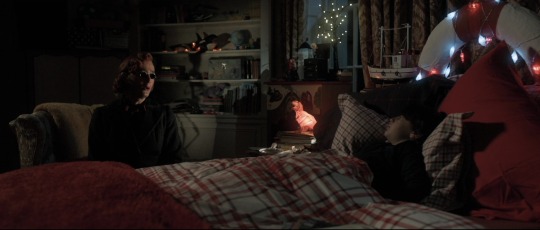

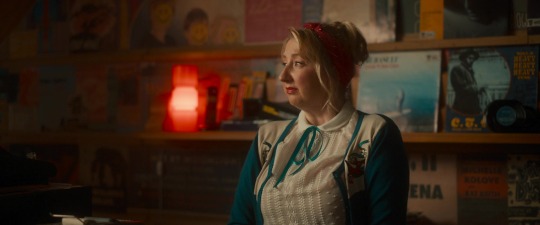
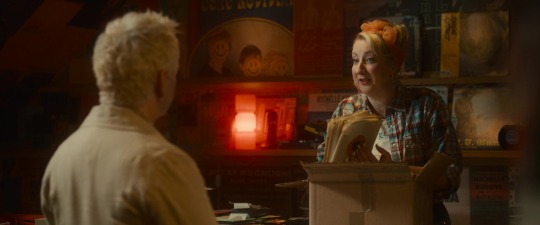
Are we following a procession of believers happy to embrace their one and true Savior? Or are they actually protesters on their way to dethrone the authority and the system?
Guess we will have to wait and see.
#the good omens crew is unhinged#everything has a meaning#title sequence#angels everywhere#archangel fucking gabriel#gabriel’s statue#bookshop statues#statues update#ponte sant’angelo#let there be light#good omens analysis#good omens meta#bible fanfiction#yuri is doing her thing
159 notes
·
View notes
Photo
















a small price to pay for getting a genuine smile
#meta knight#galacta knight#kirby#post's art gallery#your honor they are absolute goons and I adore them#yes GK did shove dandelions in there and the fluff will get everywhere the moment MK takes his eyes off it
1K notes
·
View notes
Text
Has anyone stopped to think about how, like, Lavellan wouldn't be able to forget about Solas even if she wanted to?
"It's been 8 years since Trespasser. She should have moved on by now." Like, how? If she didn't disband the Inquisition and still leads it, then trying to stop Solas is literally her everyday life.
And maybe she left and rejoined her clan. Can you imagine every day looking at faces with vallaslin and remembering how Solas said the evanuris weren't who the Dalish thought they were? Or performing Dalish customs and wondering if any of it actually connects to Ancient Arlathan? And that, god dammit, Solas would know the answer - and she probably wouldn't like it? How about any exclamations of "By the Dread Wolf!"?"
God forbid your Lavellan travels after the events of DAI because we know those Dread Wolf statues are everywhere. (And that they sit outside Dalish clans).
And maybe, like my Lavellan, she decides not to go home. But she still want to research and learn all she can about the past. Everything she could possibly uncover could link back to him. Certainly anything elven. But even Dwarven ruins aren't safe because we know the elves missed with stuff there. Ancient history isn't safe. Even studying modern cultures - like the Avvar who are so friendly with spirits and thinking about how much Solas would fucking love it!
If Lavellan's a mage and has any discussions on spirits or the Fade - of course she's going to be thinking about what Solas knew.
Maybe she joins the Red Jenny's and tries to heal things one person at a time. How can she not think about how much Solas only ever wanted to help people? But that he's also going to tear down the Veil and kill everyone? Is anything she's doing right now even going to matter in a few years? If only she could show him small incremental change that he could be doing right now instead of total destruction.
How can she not think about him all the fucking time? How does this girl keep from going insane?
Remember, there's a scar in the sky from where they closed the breach. She's going to see that every damn day.
Also her arm is gone from when he took it right before disappearing again, so that's also a constant reminder.
Nowhere is safe for this woman.
She should just escape reality and drift off into Fad-
130 notes
·
View notes
Text










annatar + celebrimbor // brandon + phillip ( rope, 1948 )
"I've always wished for more artistic talent. Well, murder can be an art, too. The power to kill can be just as satisfying as the power to create."
#the rings of power#rings of power#trop#rop#tropedits#ropedits#trop meta#rop meta#silvergifting#sauron#mairon#annatar#celebrimbor#telperinquar#in my cinephile era#look i finally watch the first toxic yaoi movie and#the parallels between the two of them got me screaming#there IS silvergifting everywhere for those who sees
46 notes
·
View notes
Text


[ The Forgotten Land Roleswap: Chapter 2 58-59]
<- Previous Page
Next Page ->
#I am throwing purple blue and pink paint everywhere!! :D#forgotten land roleswap#roleswap comic#kirby and the forgotten land#Kirby series#Kirby au#Kirby comic#king dedede#meta knight#Elfilis#beast pack#waddle Dee#art
269 notes
·
View notes